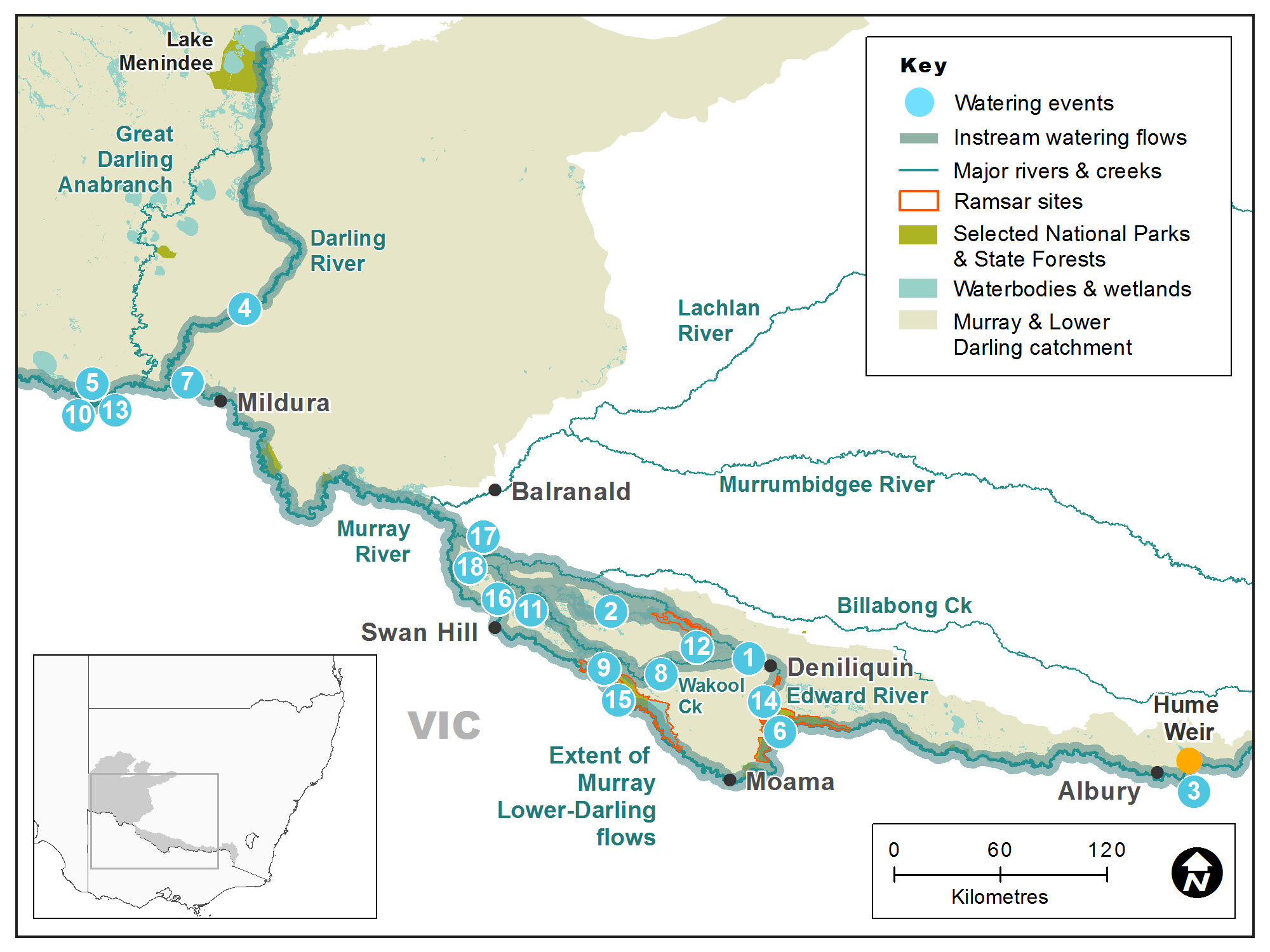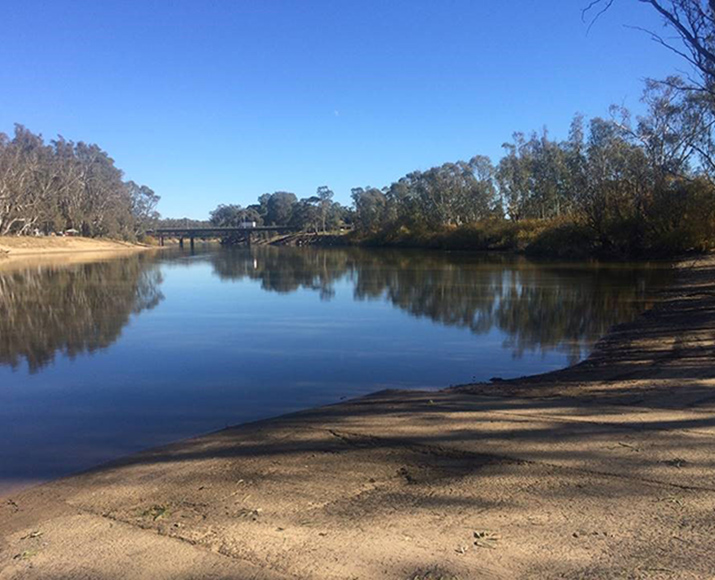In the Murray and Lower Darling catchments in 2017–18, managed watering events resulted in significant ecological outcomes for native fish, habitat condition and system productivity.
In the Murray catchment, water storages were near capacity, paving the way for the delivery of 334 gigalitres of water for the environment across 18 events targeting waterways, floodplains and multiple private property wetlands.
Co-ordinated flows involving water managers from 3 states and the Australian Government achieved multiple outcomes by connecting the river system and floodplain wetlands on a landscape scale. These carefully managed events:
- triggered breeding and movement of native fish
- provided a boost in river productivity to underpin the aquatic food web
- supported a myriad of wetland plants that provide important habitat instream and across the surrounding floodplains.
The threatened southern bell frog was the focus of water delivered into 11 private wetlands during spring using the Murray Irrigation system and private pumping. Southern bell frogs were recorded at all targeted sites and juveniles observed at several locations indicated successful breeding.

Map of the Murray-Darling catchment showing waterways, wetlands and locations of water for the environment deliveries made in 2017–18.
Watering aims
After a wet year in 2016–17, dry conditions were forecast for 2017–18. Water managers:
- identified priority actions for the year ahead to build on the gains of the previous 12 months
- prepared to use a portion of the available water to target system-wide outcomes while retaining some in reserve for future years.
OEH partnered with the NSW, Victorian, South Australian and Australian Governments to deliver water strategically throughout the river system to provide for the year-round needs of plants and animals.
The watering events aimed to:
- connect the floodplain wetlands with the river, providing opportunities for native fish to feed, breed and move
- release essential nutrients from the floodplain floor to boost the aquatic food web
- encourage the ongoing recovery of wetland plants to provide habitat, feeding and breeding opportunities
- provide foraging opportunities for waterbirds
- replenish wetland refuges in anticipation of dry times in the future.
Water delivery
This table provides a summary of water for the environment delivered in the Murray-Lower Darling catchment during the 2017–18 watering year. Volumes are indicative only.
Notes: Location numbers in the table relate to watering events marked on the map.
NSW = NSW licensed environmental water; CEW = Commonwealth licensed environmental water; EWA = Environmental water allowance accrued under the Water Sharing Plan for the NSW Murray and Lower Darling Regulated Rivers Water Sources 2016; TLM = The Living Murray; RMIF = River Murray Increased Flows
| Watering event number | Location | Start date | Finish date | NSW | CEW | EWA | TLM | RMIF | Total |
|---|---|---|---|---|---|---|---|---|---|
| 1 | Yallakool–Wakool flows | 1 Jul 2017 | 30 Jun 2018 | – | 24,367 | – | – | – | 24,367 |
| 2 | Colligen–Niemur flows | 1 Jul 2017 | 1 May 2018 | – | 20,201 | – | – | – | 20,201 |
| 3 | River Murray Multi-Site | 1 Jul 2017 | 26 May 2017 | 3543 | 150,731 | 5812 | 56,000 | 15,131 | 231,217 |
| 4 | Lower Darling River | 1 Jul 2017 | 11 Dec 2017 | – | 2738 | – | 23,072 | – | 25,810 |
| 5 | Weirpool manipulation | 1 Jul 2017 | 30 Jun 2017 | – | 2490 | – | – | – | 2490 |
| 6 | Millewa Regulators, Murray Valley National Park | 10 Jul 2017 | 21 Sep 2017 | – | 1672 | – | 3834 | – | 5506 |
| 7 | Thegoa Lagoon | 1 May 2017 | 30 Jun 2018 | 2000 | – | – | – | – | 2000 |
| 8 | Murray Irrigation Ltd | 22 Aug 2017 | 8 May 2018 | 4259 | 2574 | – | – | – | 6833 |
| 9 | The Pollack | 26 Sep 2017 | 22 Jan 2018 | 2034 | – | – | – | – | 2034 |
| 10 | Wingillie Wetlands | 28 Sep 2017 | 25 May 2018 | – | 1390 | – | – | – | 1390 |
| 11 | Central Murray river pumpers | 4 Oct 2017 | 14 Jun 2018 | 976 | – | – | – | – | 976 |
| 12 | Elimdale Wetland | 6 Oct 2017 | 18 Oct 2017 | 150 | – | – | – | – | 150 |
| 13 | Lucerne Day | 7 Oct 2017 | 11 Oct 2017 | – | 82 | – | – | – | 82 |
| 14 | Reed Beds, Murray Valley National Park | 30 Dec 2017 | 21 Feb 2018 | 4709 | – | – | – | 2044 | 6753 |
| 15 | Barham Lake | 23 Jan 2018 | 23 Mar 2018 | – | 102 | – | – | – | 102 |
| 16 | Speewa Creek | 3 May 2018 | 3 Jun 2018 | 1000 | – | – | – | – | 1000 |
| 17 | Bingera Creek | 15 May 2018 | 27 Jun 2018 | 500 | – | – | – | – | 500 |
| 18 | Wee Wee Creek | 16 May 2018 | 15 Jun 2018 | 2500 | – | – | – | – | 2500 |
| Region | Total |
|---|---|
| NSW | 21,671 |
| CEW | 206,347 |
| EWA | 5,812 |
| TLM | 82,906 |
| RMIF | 17,175 |
| Total | 333,911 |
Outcomes
In the Murray and Lower Darling catchments, OEH managed the delivery of 334 gigalitres of water to rivers, creeks and wetlands on private and public land.
A flow in the Lower Darling triggered breeding among Murray cod and enabled this important population to connect with the Murray River. This event built on the success of a breeding event the previous year.
OEH worked with a variety of partner agencies to manage a delivery of water that connected the Murray River with the Millewa Wetlands and Edward-Wakool river system. This event:
- connected the river and floodplain
- increased access to habitat for native fish
- boosted food production for native fish
- encouraged breeding and movement of native fish.
Water for the environment was also used to sustain waterbird breeding events and support the endangered southern bell frog. Flows also recharged groundwater reserves, supporting a myriad of wetland plants including iconic river red gums and Moira grass plains.
Case study
Water managers from 3 states and the Commonwealth worked together to achieve a co-ordinated sequence of flows that provided significant ecological benefits to rivers and wetlands in New South Wales, Victoria and South Australia.
A total of 310.5 gigalitres of New South Wales allocation (alongside Victorian water for the environment) was delivered to the Murray River and connected Millewa Wetlands along with the Edward-Wakool river system during 2017–18.
The movement of water through these systems promoted native fish breeding and movement. The connectivity this water movement provided also boosted food production in wetlands and the river channel.
In the Millewa precinct, these flows supported Moira grass germination and seeding. The Moira grass plains in the Millewa are a critical wetland type and part of the NSW Central Murray Forests, which is a wetland of international importance recognised under the Ramsar Convention.
Flows recharged groundwater reserves, supported a myriad of wetland plants and provided important habitat both instream and across the surrounding floodplains.
Managed flows also helped sustain bird breeding events, including colonial-nesting ibis, spoonbills, cormorants, darters and the threatened Australasian bittern.
The delivery of water for the environment is part of an ongoing process to support the recovery of rivers, wetlands, plants and animals that were impacted by the millennium drought. System-wide water management is allowing OEH and its partners to use water efficiently for maximum environmental and community benefit.

The Murray River at Tocumwal, New South Wales